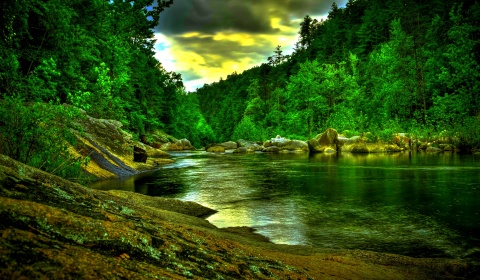Destruction of forests by man

The world's rain forests could completely vanish in a hundred years at the current rate of deforestation. Deforestation is clearing Earth's forests on a massive scale, often resulting in damage to the quality of the land.
Deforestation is the permanent destruction of forests in order to make the land available for other uses. Deforestation refers to the cutting, clearing, and removal of rainforest or related ecosystems into less bio-diverse ecosystems such as pasture, crop-land, or plantations.
Deforestation is considered to be one of the contributing factors to global climate change. Forests are cut down for many reasons, but most of them are related to money or to people's need to provide for their families. The biggest driver of deforestation is agriculture. Farmers cut forests to provide more room for planting crops or grazing livestock. Often many small farmers will each clear a few acres to feed their families by cutting down trees and burning them in a process known as "slash and burn" agriculture.
CAUSES OF DEFORESTRATION !

Logging operations, which provide the world's wood and paper products, also cut countless trees each year. Loggers, some of them acting illegally, also build roads to access more and more remote forests which lead to further deforestation.

Mining is the extraction (removal) of minerals and metals from earth. Manganese, tantalum, cassiterite, copper, tin, nickel, bauxite (aluminum ore), iron ore, gold, silver, and diamonds Mining is generally very destructive to the environment. It is one of the main causes of deforestation. In order to mine, trees and vegetation are cleared and burned.
Deforestation is typically done to make more land available for housing and urbanization, timber, large scale cash crops such as soy and palm oil, and cattle ranching.
Common methods of deforestation are burning trees and clear cutting, which is the controversial practice of complete removal of a given tract of forest.
Burning can be done quickly, in vast swaths of land for plantation use, or more slowly with the slash-and-burn technique. This destructive practice entails cutting down a patch of trees, burning them, and growing crops on the land until the soil becomes too degraded from overgrazing and sun exposure for new growth. Then, the farmers move on to a new patch of land.
EFFECTS OF DEFORESTRATION
Deforestation has many negative effects on the environment.
Loss of Species:
Seventy percent of the world's plants and animals live in forests and are losing their habitats to deforestation. The world's forests, swamps, plains, lakes, and other habitats continue to disappear as they are harvested for human consumption and cleared to make way for agriculture, housing, roads, pipelines and the other hallmarks of industrial development. Habitat loss is probably the greatest threat to the variety of life on this planet today.
Soil Erosion:
Without tree roots to anchor the soil and with increased exposure to sun, the soil can dry out, leading to problems like increased flooding and inability to farm. The loss of trees, which anchor the soil with their roots, causes widespread erosion throughout the tropics. Besides damaging the fisheries industry, deforestation-induced erosion can undermine roads and highways that cross through the forest. Half of the topsoil on the planet has been lost in the last 150 years.
DESERTIFICATION:
Deforestation also drives climate change. Forest soils are moist, but without protection from sun-blocking tree cover they quickly dry out. As the desertification takes place, the landscape may progress through different stages and continuously transform in appearance. On gradually sloped terrain, desertification can create increasingly larger empty spaces over a large strip of land. Desertification reduces the ability of land to support life, affecting wild species, domestic animals, agricultural crops and people. The reduction in plant cover that accompanies desertification leads to accelerated soil erosion by wind and water.
Desertification reduces the ability of land to support life, affecting wild species, domestic animals, agricultural crops and people. The reduction in plant cover that accompanies desertification leads to accelerated soil erosion by wind and water.

REMEDIES FOR DEFORESTRATION:
The quickest solution to deforestation would be to simply stop cutting down trees. Though deforestation rates have slowed a bit in recent years, financial realities make this unlikely to occur.
A more workable solution is to carefully manage forest resources by eliminating clear-cutting to make sure that forest environments remain intact. The cutting that does occur should be balanced by the planting of enough young trees to replace the older ones felled in any given forest.

